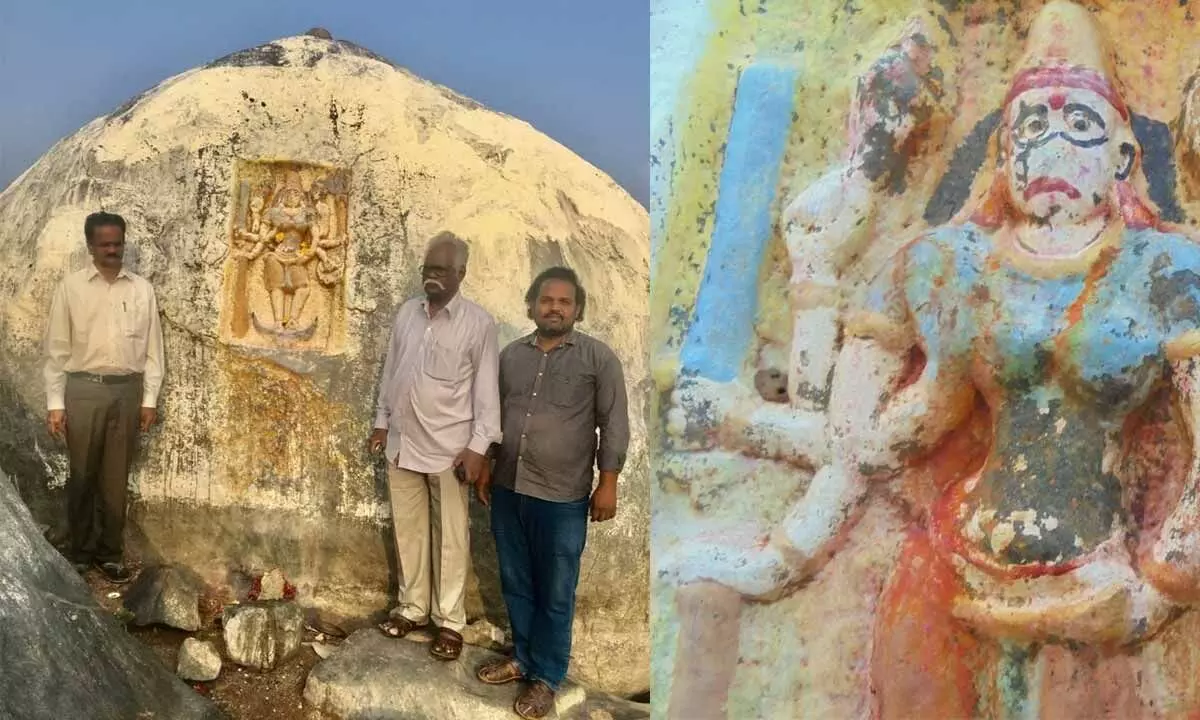Live
- PM Modi tears into Gandhi family for its habit of amending Constitution
- Young Kabaddi Player Dies of Heart Attack During Match in Mandya
- Exciting Return of Santosh Trophy Football Tournament Kicks Off in Hyderabad
- Head Constable Dies by Suicide, Cites harssament by wife and inlaws
- Delhi BJP claims AAP govt will never pay women allowance like in Punjab
- India is 'Mother of Democracy': PM Modi
- ‘One nation, one election’ will undermine India’s federal structure: Mehbooba Mufti
- Vikram collaborates with director Madon Ashwin for ‘Chiyaan63’
- ‘Bachhala Malli’ trailer heightens anticipation
- Karnataka quota row: Backward Class forum chief warns Lingayat seer over 'tinkering with reservations'
Just In
Ongole: Plea for protection of 1000-year-old Chalukyan era Durga sculpture


Dr Emani Sivanagireddy and others at the sculpture of Mahishasuramardhini at Peda Alavulapadu in PC Palle mandal on Sunday
Noted archaeologist from Andhra Pradesh and CEO of Pleach India Foundation, Dr Emani Sivanagi Reddy revealed that the sculpture which is being prayed as Paleti Ganga by the locals at Peda Alavulapadu village in Pedacherlopalle mandal of Prakasam district, is in fact the sculpture of Mahishasuramardhini, hewn on the rock in 10th century during Chalukyan era.
Ongole(Prakasam District): Noted archaeologist from Andhra Pradesh and CEO of Pleach India Foundation, Dr Emani Sivanagi Reddy revealed that the sculpture which is being prayed as Paleti Ganga by the locals at Peda Alavulapadu village in Pedacherlopalle mandal of Prakasam district, is in fact the sculpture of Mahishasuramardhini, hewn on the rock in 10th century during Chalukyan era.
Dr Sivanagi Reddy is documenting the historical remains in the villages of Erragaddapdu, Lingalakonda and Peda Alavulapadu that are associated with the popular folklore 'Katamaraju Katha', which narrates the fight between the forces of Katamaraju and Manumasiddhi in the 13the century.
With reference to the research by Prof TV Subbarao on Katamaraju, following the information from well-known historian from Prakasam district Dr Jyothi Chandramouli, Dr Sivanagi Reddy inspected the rock sculpture on Sunday and revealed the historical significance of the sculpture.
Dr Sivanagi Reddy told that the sculpture measuring 4.5 X 2.5 X 0.3 ft in length, breadth and depth, and the woman deity is standing at ease on the head of Mahishasura and holding sankha, chakra, khadga, sula, gada and dalu in her eight hands. He said that she is also called as Vishnu-Durga and
the sculpture belongs to the Eastern Chalukyan period, 10th century AD.
Dr Sivanagi Reddy and Dr Chandramouli lamented that the idol is prone to deterioration and damage to its antiquity due to the deliberate coating of chemical colours every summer during the annual festival celebrated by the locals, who are not aware of its historical importance. Dr Chandramouli said that there is an inscription engraved on a boulder located next to this sculpture issued by certain Ravuri Raghavareddy in 1526 AD, of Sri Krishnadevaraya's reign period, and records gifting away of a village Gangapatnam in Kanigiri- Polacharla- Musunduru Seema, a territorial division of the Vijayanagara empire towards the shodasopachara of Someswara Swamy and Bagadi Ganga of Lingalakonda.
Dr Sivanagi Reddy and Dr Chandramouli tried to sensitise the villagers of Peda Alavulapadu on the historical significance of the spot and sculpture. They urged the villagers to stop using the chemical colours, and remove the existing colours immediately to bring back the original look of the historically valuable Mahishamardhini sculpture. They said that they are ready to offer technical guidance needed in this regard and also to draft a legend with historical and iconographical details to display for the benefit of the visitors and research scholars. They appealed to the local government to take care of the idol and its upkeep, and also to provide an approach road to facilitate the visitors. Dr Karunanidhi, an amateur historian of Kanigiri also participated in the documentation programme.

© 2024 Hyderabad Media House Limited/The Hans India. All rights reserved. Powered by hocalwire.com






